History and location
Historically, during the late 19th-century expansion of Amsterdam, The Halls (De Hallen, in Dutch), was a tram depot in a closed enclave characterised by long closed brick blocks with monumental facades facing the street. De Hallen was a traditional, functionalist complex, necessary for the maintenance of the first electric trams at the beginning of the 20th century. The complex was hidden between the Ten Kate Market, Kinker Street and Tollens Street, in the middle of a working and lively neighbourhood.
Though an active area, De Hallen was only accessible for those who worked at the tram depot. At the beginning of the 20th century, many people found work here. There were different kinds of workshops in the depot for craftsmen, like wood and metal workshops as well as a forge. There was also a laundry and space for the offices of the company. De Hallen, Amsterdam, is a national monument built in phases between 1901 and 1928 and has some very characteristic design features. The structure of the long halls (7) and the passage at the end is unique. The halls were accessible from two sides.
It was as if no suitable adaptive reuse could be found for De Hallen and the building may have to be demolished
All doors opened into the transverse hall called the ‘traversing hall’. This housed a locomotive wagon track, so that the trams could be easily moved to another track or hall without changing direction. At the eastern end of the wagon track was a turntable to rotate the trams by 90 degrees and enable them to ride out to Tollens Street through the eastern exit. De Hallen is the only tram depot in the Netherlands, which still has its original characteristic series of roofs.
In 1997 the tram depot lost its original function and many different new users found a temporary working space in the empty halls. For nearly a decade many initiatives were developed in co-operation with the local municipality architects, developers, residents and the new temporary users. However, all plans failed due to lack of finance and local resistance. It was as if no suitable adaptive reuse could be found for De Hallen and the building may have to be demolished.
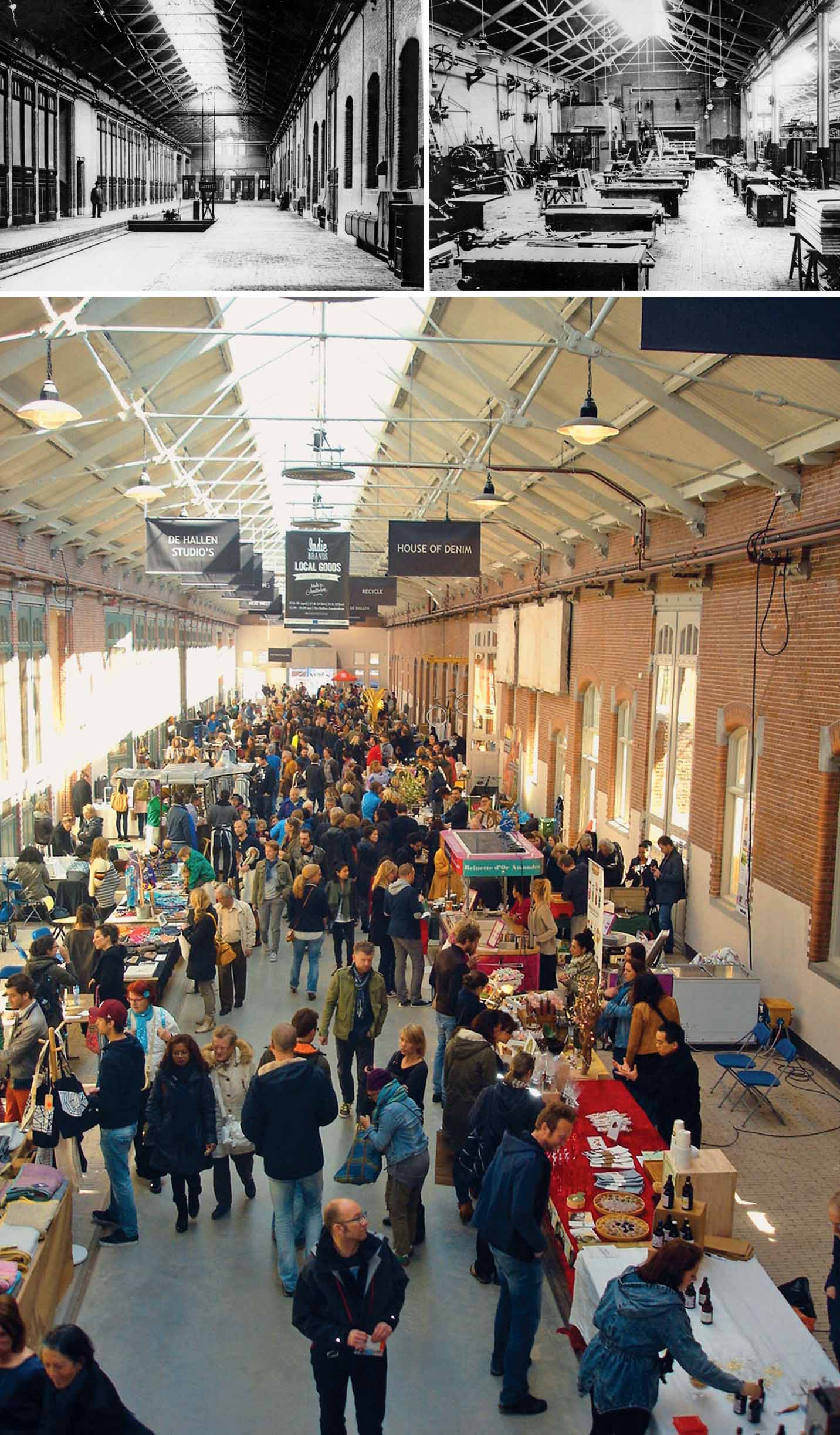
Bottom: Weekend Market Passage
Heritage protection
However, a group of residents and architects in the neighbourhood committee for the De Hallen area were convinced that this building needed reuse and preservation. In order to avoid demolition, in 1999 they obtained the status of a national monument for the building complex. One of the architects came up with Covent Garden, London, as a reference for adaptive reuse. De Hallen seemed to fit the vision of ‘an oyster with a pearl inside.’
From initiative to Foundation TROM
After 10 years of commercial plan-making failed, a social plan was developed and was successful. In the spring of 2010, local residents, future users, architect André van Stigt and other stakeholders and supporters set up the Tram Remise Development Company (TROM). The aim of the TROM initiative group was to give new life to a beautiful industrial monument with a visibly rich history in a part of Amsterdam where such monuments are rare, so that people could be proud of their surroundings.
Brief description of the conservation work
The challenge was to bring the building into the 21st century and to open and connect it to its surroundings. The future users were closely involved in making the complex a magnet for people from all over the city and creating an area where users would find it a pleasure to work.
The initiative was taken with the aim to ensure that the national monument had social ambition and not financial ambition with social risks
Scope of the project
1. To make a new, sustainable and high quality complex at De Hallen in West Amsterdam.
2. Connect with the needs and desires of the neighbourhood and give the complex a metropolitan atmosphere.
3. To make the realisation and operation financially feasible, without any governmental subsidy.
4. To open up the building for the public and to connect it to its surroundings.
The TROM Foundation will remain involved in the project for at least 10 years. They will also be responsible for the maintenance contract, signed with the contractors at the beginning of the process. So from the very beginning the contractors are made responsible for the conservation of the building for the future.
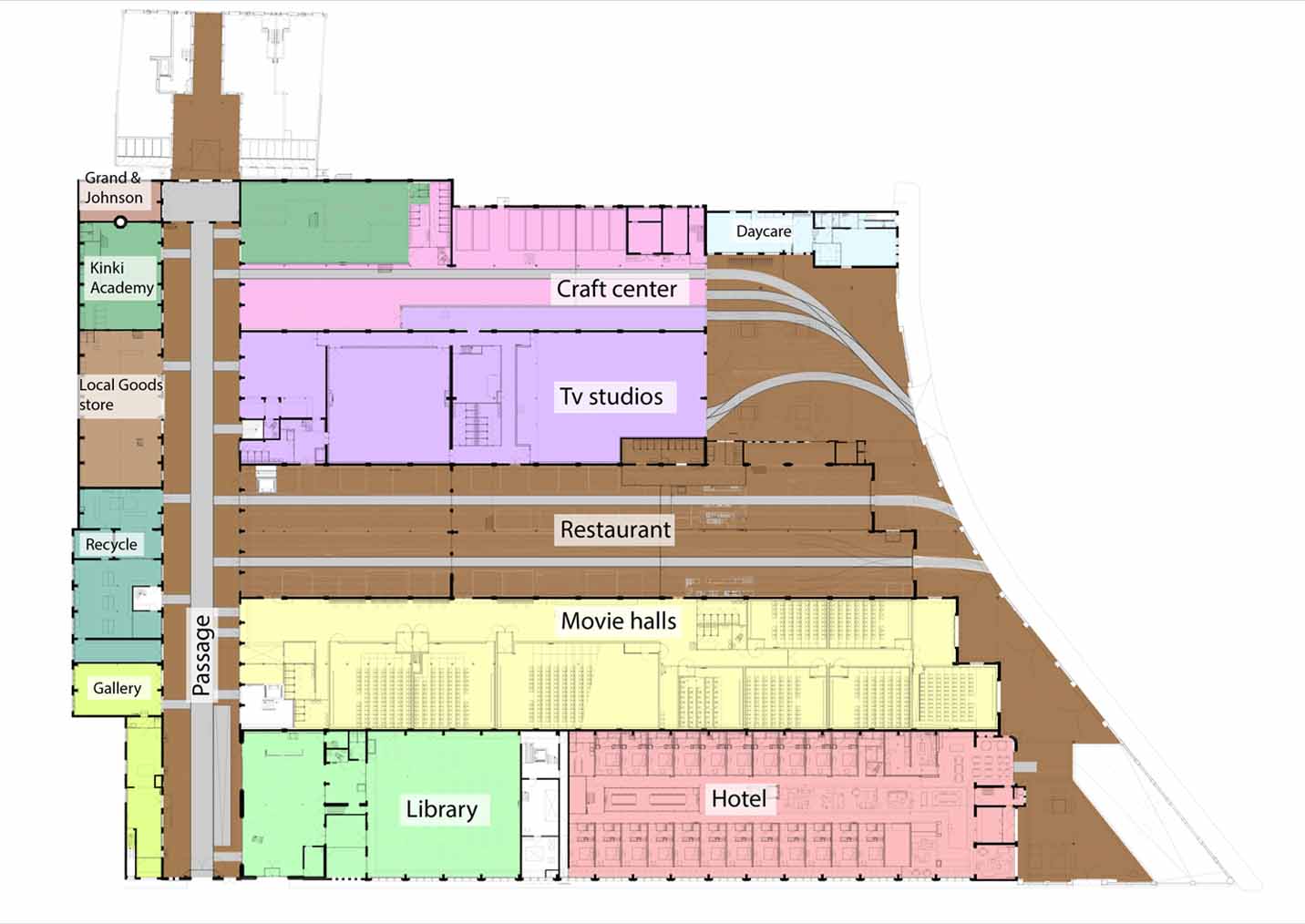 |
Cooperation
De Hallen, Amsterdam, had to function at both the neighbourhood and the urban level. TROM wanted a planning process in which promoters, local residents, prospective users, builders and financiers were committed to the root targets. This decision by TROM was very important during the development of the plan and is crucial in the management phase.
Social importance
The initiative was taken with the aim to ensure that the national monument had social ambition and not financial ambition with social risks. The TROM Foundation, established by the promoters, is therefore also a non-profit organisation. Of course, there were technical and financial considerations. Therefore an independent board of constructional and financial experts was created. This board maintains contact with promoters, local residents, users and other stakeholders.
The library and the reading café, Belcampo, are the living room of the neighbourhood
Private financing
An important feature of the plan for De Hallen concerned financing. To continue the desired mix of commercial and social functions in the complex, without subsidies in development, creativity was needed and a solid plan was formulated involving different parties and private investors.
Create interest for work
The number of people with the knowledge, skill and experience to restore and maintain monuments is fast reducing in European cities. Also, the number of young people in Amsterdam with these skills is decreasing, since there are fewer internships and most youngsters are not too keen on studying the craft of building. With the redevelopment of the former tram depot, several internships were integrated. The idea behind this was to let young people participate in the maintenance of De Hallen under the supervision of teachers. There were also internships offered by several tenants. These were created for people from different schools as well as for people located at a distance from the labour market
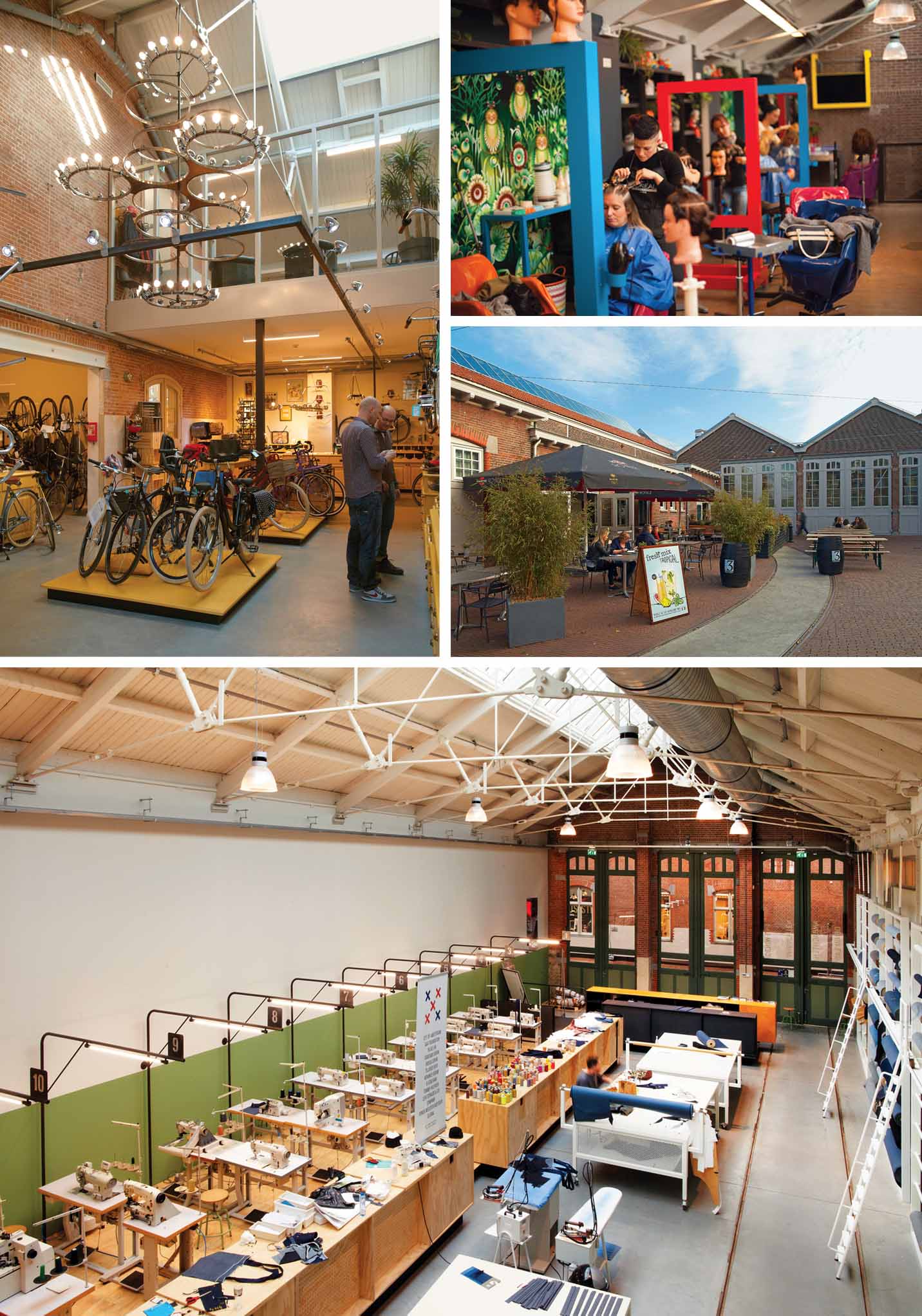
Top Right : Kinki Academy and Youngbloods hair dresser and training centre
Middle : Terrace Bellamy Square
Bottom: House of Denim
Design, sustainability and complexity
The architect wanted a building that was not only sustainable but also met the technical requirements of the 21st century. LED lighting, floor-heating and cooling, a mechanical ventilation system and an efficient state-of-the-art energy system guaranteed lower maintenance costs for the new users. Since Halls 1, 2 and 3 needed new foundations, a basement parking for cars was built there.
Functions were implemented on the basis of a programme of requirements that was suitable for the building. All the roofs in De Hallen were kept in sight; it was possible to have light even in the Film Halls if needed, by opening the screens. Throughout the design process the criteria for reuse of the national monument had to be respected.
De Hallen Amsterdam, today
Renovation started in January 2013. The first phase was completed in April 2014 and the second in September 2014. In comparison to the expected number of 500,000 visitors a year, in its first two years of operation De Hallen has attracted more than two million visitors annually.
The Cinema Halls alone have more than 400,000 paying visitors each year. The New York Times wrote about this beautiful spot in Amsterdam; Lonely Planet was happy to mention it in their list of top 20 things to do in Amsterdam.
De Hallen is a unique project in which different aspects of urban leisure have been combined
The tenants of the Halls
Both social and commercial tenants are now located in De Hallen. During the development of this building the classification of the spaces was taken into account with the intended functions, in order to maintain the original state of the monument as much as possible.
Hall 1: The library and the reading café, Belcampo, are the living room of the neighbourhood. No alcohol is served here, but many people drop in to drink coffee and read the daily papers. Young people come here to study. Belcampo’s cultural entrepreneur organises a cultural programme for people with different interests.
More than 175,000 visited the library in the first year and that number is constantly growing.
Hotel de Hallen has its entrance on Bellamy Square. It is a design hotel with an industrial touch, a trendy vintage Scandinavian interior with a beautiful lobby, 55 luxury rooms and a lot of modern art in the public spaces. The restaurant, Remise 47, has a nice terrace with plants and plenty of sunlight.
Hall 2: Film Halls is a combination of art house and regular cinema with 9 screens. Film Halls has varied programmes. Here, one can watch the better films from Hollywood and Europe, documentaries for film lovers, films for kids and families, film festivals and special events. In the Film Halls, the old Parisian Theatre (1924), seen as a world heritage monument and owned by the family Desmet, has been added as one of the theatres.
Hall 3: This is a place for food and drinks, where visitors can munch their way through a selection of upmarket street foods, all located around a central bar. The Food Court is located in one of the oldest halls. Due to its public function and use, a second public exit has been realised in addition to the one on the main passage. The restaurants are on the Bellamy Square side and opposite them is a spacious terrace.
Hall 4: De Hallen Studios meets the demand for professional television studios in the inner city of Amsterdam, which are easily accessible to audiences for various shows and programmes. The studios can also be used as special venues for various events, such as presentations, conferences, seminars, parties and cultural programmes. This is also an official venue for marriages. A professional team, NTVF Productions BV, runs the studios. Hall 4 has two studios on the ground floor and the production functions and offices on the first floor.
Hall 5: House of Denim is a platform for craftsmanship and innovation in the denim industry. Through the development of education, innovation, enterprise and networking projects, it strives to make the world of jeans ‘dryer, cleaner and smarter.’
Hall 6: The life-blood of De Hallen is ‘the Passage’ that connects the Bilderdijkkade and Ten Kate Market. The Passage consists of two parts: The first major section and the second smaller passage, located in the extension (1908) of the former tram depot.
The entrance for almost all users is from the Passage, except for the hotel and the nursery. The Passage has a public function, it’s the ideal place for special markets such as the Local Goods Market, exhibitions, the red carpet for the Film Halls and live TV-productions in cooperation with the Studios.
Hall 7: Several relatively smaller units, with a diversity of creative tenants have settled down here. There are two social firms: Gallery Beeldend Gesproken and the bike shop, Re-Cycle. The Local Goods store has a variety of young local entrepreneurs and is a place for creative thinkers, craftsmen and cultural connoisseurs. Local Goods also organises the special weekend markets in the main Passage. Kinki Academy and Youngbloods has a training centre to become a hairdresser and you can also get your hair cut here. At the Ten Kate Gate one can find Grand & Johnson, a designer company.
Inside the complex are some hidden spots on the first floor of the erstwhile tram depot, which can only be reached by the staircase or elevators from the parking garage. Company 1Media, a multi-media company, and the canteen and offices of the Studios, are also located there.
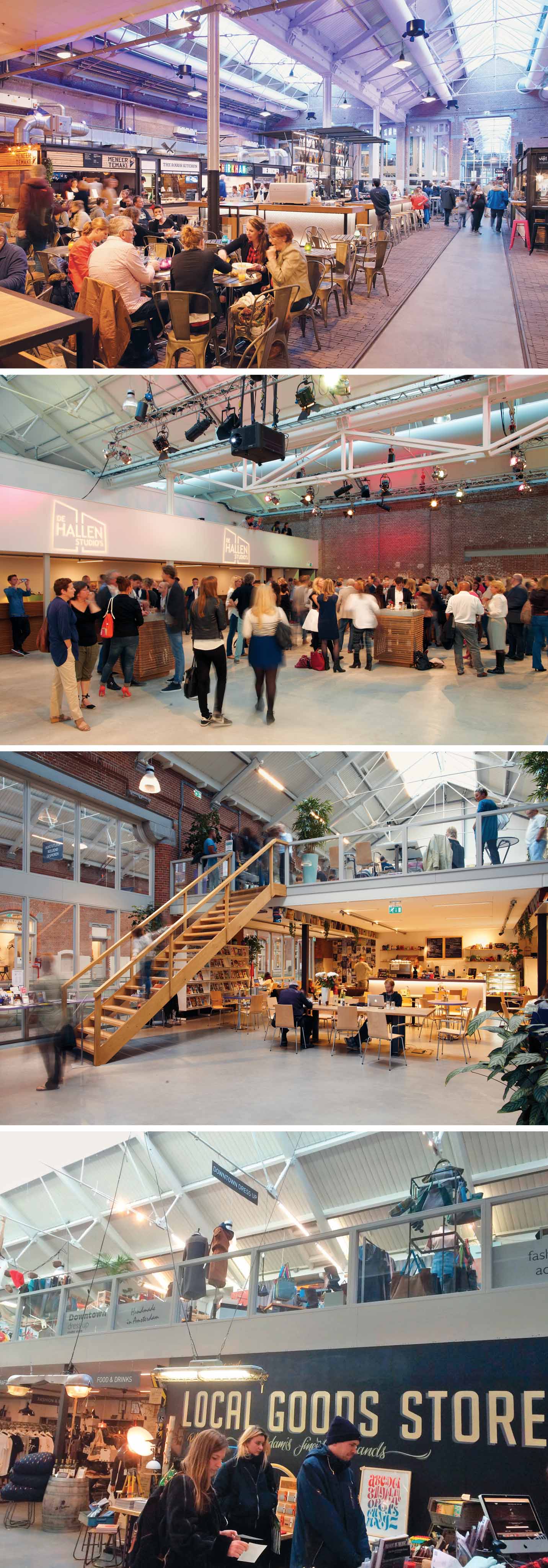
Middle first : TV Studio
Middle second : Belcampo Cafe
Bottom : Local Goods Store
Nursery
In this complex there’s a nursery on the Bellamy Square side called World Kids. They offer day care for children from the age of 8 weeks to 4 years. There is a small outdoor playground, close to the terraces.
Small Passage
In this old part of the former tram depot, six big apartments have been built for the Hotel where guests can stay for a week or longer. There are also some small shops.
Cooperation between all tenants
Almost all tenants were already involved in the project since inception, so from the very beginning they were aware about the social firms, the commercial firms and the differences in the rental prices.
Altogether, De Hallen has a dynamic mix of users. If there is a presentation at the De Hallen Studios, guests can put up at the hotel or dine at one of the restaurants. Also, on a smaller scale, cooperation between the cultural entrepreneurs of Belcampo and the Gallery or Local Goods results in public exhibitions and cultural Sundays in the Passage. Users also cooperate in workplace training and multifunctional use of one another’s facilities.
Parking and bicycle parking
On the Bellamy Square side, close to Hotel de Hallen, is the entrance to the parking garage for 165 cars. The Passage also has an entrance to free bicycle parking; there’s enough space for about 500 bicycles.
De Hallen is a unique project in which different aspects of urban leisure have been combined in an old monumental building located in an old urban part of Amsterdam. It is an urban magnet of the kind that is rarely seen and has only been possible due to unique cooperation between socially engaged citizens and professionals.
Fact Sheet Programme: Total 22.000m² Under Halls 1, 2 and 3 a car and bicycle parking has been constructed (6.000 m²) Total investment: € 37.5 million of which To know more log on to www.burovanstigt.nl |
All photos: Hans Kuiper


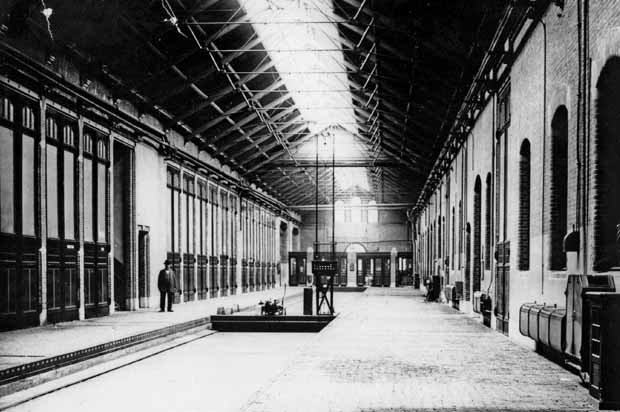

Comments (0)